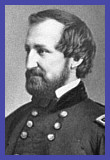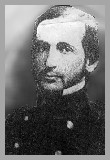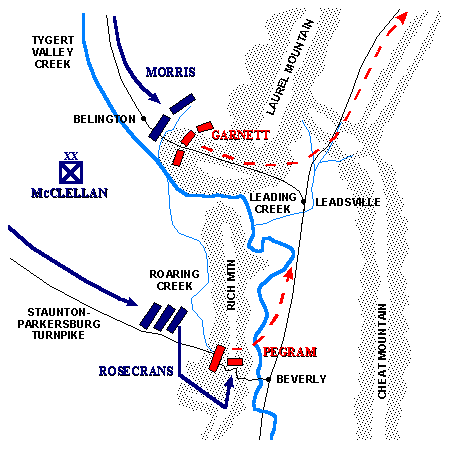| Union: Major General George B. McClellan Brigadier General Thomas A. Morris Brigadier General William S. Rosecrans | Confederate: Brigadier General Robert B. Garnett Colonel John Pegram | |||
 McClellan |
 Rosecrans |
 Garnett |
 Pegram |
|
"No prospect of a brilliant victory shall induce me to depart from my intention of gaining success by maneuvering rather than fighting. I will not throw these raw men of mine into the teeth of artillery and entrenchements if it is possible to avoid it."
-- Major General George B. McClellan, on Roaring Flats facing Camp Garnett, July 1861.
"Our success is complete and secession is killed in this country."
-- Major General George B. McClellan, telegram to Washington, July 1861.
"[You have] annihilated two armies, commanded by educated and experienced soldiers, entrenched in mountain fortresses fortified at their leisure"
-- Major General George B. McClellan, official order to his troops, July 1861.
Principal Commanders
| Union: Major General George B. McClellan Brigadier General Thomas A. Morris Brigadier General William S. Rosecrans | Confederate: Brigadier General Robert B. Garnett Colonel John Pegram | |||
 McClellan |
 Rosecrans |
 Garnett |
 Pegram |
|
Physical Features
South of Laurel Mountain the Tygart Valley opens into a broad valley. Sliding off the west side of this valley out of Cheat Mountin, the Staunton-Parkersburg Turnpike meandered north through this fertile farmland. At Beverly, it turned west through the Rich Mountain Pass on its way to Buckhannon. The pass was too valuable not to protect, but since Union forces were approaching from a more northerly direction -- from Grafton and Philippi -- It was only logical that the Confederates would place the bulk of their force at the northwest end of this valley, along the base of Laurel Mountain.
The Confederate camp was established at the western base of Laurel Mountain east of Belington, on Laurel Hill. Entrenchments of stones, felled trees, and abatis were erected running up the hill from the south side of the turnpike that ran from Philippi to Beverly. On the north side of the road were additional entrenchments running to the foot of Laurel Mountain, as well as three artillery positions. In command was Briagadier General Robert S. Garnett, who had made Camp Laural Hill his headquarters.
The smaller of Garnett's force was commanded by Colonel John Pegram at Camp Garnett in the Rich Mountain pass, on a spur near the western base of the mountain. Fortifications, extending a third of a mile, flanked both sides of the turnpike. The Confederates felled trees and removed brush 150 yards in front of the breastwork of logs, exposing a possible frontal attack. Two artillery pieces were placed near the center of the line, and one piece on each flank.
The local inhabitants assured the Confederates there were no approaches that the Federals could use to flank the position. It would be a fatal mistake. For at the top of the the mountain was the farm of the Hart family, who were sympathetic to the Union. Fearing an attack from behind if Garnett was unable to hold Laurel Hill, Pegram sent a small outpost to the top of the mountain at the Hart homestead. Little could the family have guessed the invaluable role they would play as Independence Day 1861 was celebrated for the first time over a divided nation, and a divided Virginia.
Description of the Battle
On 6 July, Morris advanced with 4,000 men from Philippi and took up a position within two miles of Garnett at Laurel Hill Fort. Morris's Federal force consisted of infantry from Indiana (7th), Ohio (6th, 15th, 16th ), [West] Virginia (1st, 2nd), as well as the 1st Ohio Light Artillery. Garnett was positioned near Elliott�s farm on the heights behind William Yeager�s house, with infantry from Georgia (1st), Virginia (9th Battalion, 20th, 23rd, 31st, 37th), as well as cavalry (Pittsylvania, Charlotte, Greenbrier, Bath, Rockbridge) and the Danville Artillery. major General George B. McClellan's plan of attack was for Morris to hold the bulk of the Confederate force in check at Laurel Hill, while he pushed from Buckhannon towards Rich Mountain to turn the flank of the entire Confederate force and trap the rebels at Beverly.
Morris's orders were to ...
"... occupy Belington by a strong advance guard, and place a strong detachment to cover the paths leading from the rebel camp to the left flank of your position. From this position push out strong infantry reconnaissances, to ascertain the exact position, condition and movement of the enemy. Watch them closely day and night. Have everything ready to pursue them should they retreat, and follow them up closely in that event."
On the morning of 7 July, Morris's Federals engaged the southerners in a series of skirmishes in the hills. From then until 11 July, both sides advanced small groups of infantry to reconnoiter, only to have infantry and artillery fire drive them back. These numerous assaults and cannon bombardments over several days kept Garnett's troops busy, without seriously challenging their position. Then, on the afternoon of 11 July, the sounds of a larger battle taking place on the top or Rich Mountain 23 miles away carried to the combatants at Laurel Hill, and Morris knew McClellan was proceeding as planned.
 |
Between 6-7 July, McClellan had moved the bulk of his force up the Staunton-Parkersburg Turnpike from Buckhannon. They encountered Confederate skirmishers at Middle Fork Bridge, but McClellan was personally able to bring his 5,000 men unhindered to Roaring Creek Flats, two miles west of Camp Garnett. Despite his numerical superiority over the Confederates, McClellan was apprehensive about the outcome of the battle. His troops had enlisted for only three months, so they were basically civilian troops. He was also deceived by a report from Confederate prisoners about the number of troops facing him -- thinking he faced eight or nine thousand troops. Consequently, he felt it would be disastrous to attack the well-entrenched position head on.
As McClellan was deciding how to assault the fortification, eighteen-year-old David Hart, the son of the family that lived at the top of Rich Mountain, appeared in camp to volunteer information about local topography. Brigadier General William S. Rosecrans questioned him and and was told by Hart of a route around the left flank of the Confederates to a point at the top of Rich Mountain, from which a dirt road ran to the Confederate position at the Hart farm. Rosecrans, perhaps less than anxious to make a frontal assault, discussed the possibility with McClellan. The commanding general approved a plan in which Rosecrans, with his brigade of 1,917 men, would march south around Camp Garnett through an unguarded mountain pass, then move down the mountain to attack Camp Garnett from te rear. McClellan would make a frontal assault the moment Rosecrans attacked the rearguard of the confederates at Camp Garnett.
Guided by Hart, Rosecrans and his men struggled though the forest, hindered by thick undergrowth, steep hillsides, and intermittent rain. Rosecrans was not particularly secretive, and Pegram could have avoided being flanked. He was not particularly well-liked by his fellow officers and subordinates, and those relations probably contibuted to Pegram's defeat. Captain Higginbotham was stationed on the left at Camp Garnett and heard the sound of axes to his left. Twice he sent word to Pegram, but was told to mind his own business, ending further communication. Unhindered, Rosecrans finally made it to the top of the ridge well to the south of the turnpike, and moved north along the top of the mountain until they overlooked the pass where the pike crossed the mountain at the Hart farm. Around 2:30 on the afternoon of 11 July, Rosecrans surprised a Confederate outpost at the pass. Captain Julius A. De Lagnel commanded the small Confederate detachment at the Hart farm with 310 men and one cannon. He had been fearing a Union flank attack from the north or east. Instead he was surprised by an assault from the south.
The Confederates took cover on the opposite side behind hastily constructed breastworks, rocks, trees, and homestead buildings. With the help of their one cannon, they held off the Federal assault for more than two hours, while McClellan waited in the valley below to launch the frontal assault. The assault by Rosecrans, with superior numbers, was not well coordinated and was hampered by the terrain. The Confederates repulsed a number of repeated assualts by small groups. Fearing his green troops would eventually become unnerved, Rosecrans decided to personally lead an attack. The oupost in the pass was overwhelmed by the charge and were forced to retreat. De Lagnel made a futile attempt to rally his men to resist the renewed Federal assault, but the Federal charge across the valley by the entire federal line of three regiments overpowered the Confederates. De Lagnel fell wounded, and ordered a retreat. From Camp Garnett, Pegram tried to bring reinforcements to the fighting behind him at the pass, but he was too late -- it had already been taken by Rosecrans.
Rosecrans orders were to turn and attack Camp Garnett to signal McClellan's frontal assualt, but he chose to wait until morning. McClellan, without communication from Rosecrans, thought the flank attack had failed, and withdrew to Roaring Flats until morning. Meanwhile, with the enemy behind him, Pegram knew he was virtually defenseless. During the night he ordered the withdrawal of his remaining forces. On the morning of 12 July, Rosecrans marched down the turnpike to Camp Garnett, which they found abandoned except for the sick and wounded. He sent word to McClellan that the enemy was defeated.
Up at Laurel Hill, Garnett had been informed of Pegram's defeat. Realizing his Laurel Hill position was cut off, he ordered skirmishers to cover withdrawal preparations. His troops pulled quietly back from Wilmoth Pass at dusk, leaving their tents up and fires burning, with the rear guard in place until the last moment. But upon reaching Leadsville (now Elkins), Garrett was mistakenly told that Beverly was in Federal hands. Instead of following the more easily travelled turnpike south to safety, he turned his column northeast over far rougher terrain.
The advance of Pegram's withdrawing Confederate column, led by renowned mapmaker Jed Hotchkiss, became separated from the main body and successfully escaped down the turnpike. Pegram and the bulk of his men did not fare so well. They escaped over Rich Mountain to about three miles south of Leadsville . There Pegram learned that Garnett had withdrawn from Laurel Hill. His troops were exhausted and unnerved by the defeat. Even though he was uncertain where the closest Union forces were located, he felt an orderly retreat was impossible. A number of his subordinates disagreed, but thinking he was cut off and without supplies, Pegram surrendered 554 of his men to McClellan in Beverly on 13 July 1861.
Results
| Army | Rich Mountain | |
|---|---|---|
| Effectives | Casualties | |
| Union | 9,000 | 46 |
| Confederate | 4,585 | 300 |
| Total | 13,585 | 346 |
Notable (Mis)Fortunes of the Principals
|
|
Return to Western Virginia |